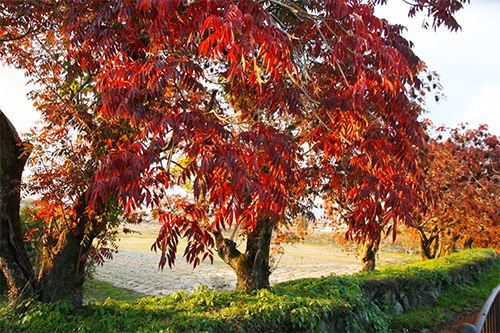


さて四国の住空間探訪ですが、わたし的にクライマックスの住宅がこちら。
内子という愛媛県内の山間の宿場町で江戸期には旧大洲藩領。
藩の殖産興業策としてローソクや化粧品原料となる「木蝋」生産に注力した。
先般紹介した「臥龍山荘」もこの産業貿易で財を成した人物の終の住み処。
この木蝋の生産、原材料の樹種「ハゼの木」の地域最大の産地がこの内子。
そこに「上芳我家住宅」として生産工房と家系の豪邸が残されている。
公開住宅ですが、あまりにも興味深く説明の方をほぼ独占取材(笑)。
おかげで同行のカミさんとはぐれてしまった(泣)。
タイムスリップ型の住宅取材の醍醐味をたっぷりと堪能させてもらった。
そもそも「木蝋」という生産物自体、よくわからなかった(笑)。
Wikipediaなどの記述では以下のようになっています。
〜木蝋(もくろう・Japan wax)とは生蝋(きろう)とも呼ばれウルシ科の
ハゼノキ(Japanese wax tree)やウルシの果実を蒸してから、
果肉や種子に含まれる融点の高い脂肪を圧搾するなどして抽出した広義の蝋。
化学的には狭義の蝋であるワックスエステルではなく、
中性脂肪(パルミチン酸、ステアリン酸、オレイン酸)を主成分とする。
搾ってからそのまま冷却して固めたものを「生蝋」(きろう)と呼ぶ。
櫨(ハゼノキ)の種類により生蝋の緑色の程度や風合いが異なる。〜

●蝋燭、特に和ろうそく(Japanese candle)の仕上げには生蝋をさらに
天日漂白した白蝋を用いる。かつては蝋燭だけでなく、びんつけ、艶出し剤、
膏薬などの医薬品や化粧品の原料として幅広く使われた。
このため商品作物として明治時代まで西日本各地で盛んに栽培されていた。
●愛媛県南予の内子では木蝋生産が盛んで江戸期・大洲藩6万石の経済を支える
大きな柱の一つであった。明治期には海外にも盛んに輸出された。
第二次世界大戦以前は日本国外にも通用する輸出品としても重要視され、
1940年には重要輸出品取締法に基づく重要輸出品目に加えられている。
●お相撲さんの髷を結う鬢付け油には木蝋が欠かせない。激しいぶつかり合いで、
その他の油では髪がバラバラになってしまう。木蝋はジャパンワックスと呼ばれ
ヨーロッパ、アメリカにずっと輸出が続いている。
ポマード、チック整髪料、クレヨン、色鉛筆、食品、医薬品、口紅など化粧品。
トナー、インクリボン、CDなどOA機器にも使わる。また天然材料であることから
シックハウス症候群対策としても良いコーティング剤が開発されている。〜
こちらの上芳我家住宅はこうした木蝋産業の記念碑的遺構。
北海道の住宅関係人としては、さまざまな意味で引き込まれる。
ということで、何回かに分けて住宅探訪ブログであります。
English version
[House of a wealthy merchant who produced “Japan wax” in the Edo period ① Shikoku living space-39]
Japanese original raw materials for cosmetics such as candle raw materials and shaving oil. It was in the limelight in Europe and the United States. Architectural exploration that is the afterglow of the industry.・ ・ ・
Now, let’s explore the living space of Shikoku, but here is the climax house for me.
Uchiko is a mountain post town in Ehime prefecture, and was the territory of the former Ozu domain during the Edo period.
As a measure to promote the clan’s breeding industry, we focused on the production of candles and “Japan wax,” which is a raw material for cosmetics.
The recently introduced “Garyu Sanso” is also the final residence of the person who made a fortune in this industrial trade.
This Uchiko is the largest producer of this wax and the raw material “Haze no Ki”.
The production workshop and the mansion of the family are left there as the “Kamihoga family residence”.
It’s a public house, but it’s so interesting that the explanation is almost exclusive (laughs).
Thanks to that, I got separated from Kami-san who accompanied me (crying).
I was able to fully enjoy the real thrill of time-slip type housing coverage.
In the first place, I didn’t really understand the product itself called “Japan wax” (laughs).
In the description such as Wikipedia, it is as follows.
~ Japan wax is also called raw wax and belongs to the family of lacquer tree.
After steaming Hazenoki (Japanese wax tree) and lacquer fruit
Wax in a broad sense extracted by squeezing fat with a high melting point contained in pulp and seeds.
It is not a wax ester, which is a wax in a narrow sense chemically.
The main component is triglyceride (palmitic acid, stearic acid, oleic acid).
The wax that has been squeezed and then cooled and hardened is called “raw wax”.
The degree and texture of the green color of raw wax varies depending on the type of hazenoki. ~
● Add more wax to finish candles, especially Japanese candles.
Use white wax bleached in the sun. In the past, not only candles, but also bottles, polishes,
Widely used as a raw material for pharmaceuticals such as plasters and cosmetics.
For this reason, it was actively cultivated in various parts of western Japan until the Meiji era as a commercial crop.
● In Uchiko, Nanyo, Ehime Prefecture, Japan wax production is flourishing and supports the economy of 60,000 stones of the Ozu clan during the Edo period.
It was one of the big pillars. During the Meiji era, it was actively exported overseas.
Before World War II, it was regarded as important as an export product that can be used outside Japan.
In 1940, it was added to the important export items under the Important Export Control Law.
● Japan wax is indispensable for the bintsuke oil that connects sumo wrestlers. In a fierce collision,
Other oils will cause your hair to fall apart. Japan wax is called Japan wax
Exports continue to Europe and the United States.
Cosmetics such as pomade, tic hair styling products, crayons, colored pencils, foods, medicines, and lipsticks.
It is also used for OA equipment such as toner, ink ribbons, and CDs. Also, because it is a natural material
A good coating agent has been developed as a countermeasure against sick building syndrome. ~
This Kamihoga family house is a monumental remains of the Japan wax industry.
As a person involved in housing in Hokkaido, I am drawn in many ways.
So, it is a housing exploration blog divided into several times.
Posted on 4月 3rd, 2022 by 三木 奎吾
Filed under: 住宅マーケティング, 日本社会・文化研究








コメントを投稿
「※誹謗中傷や、悪意のある書き込み、営利目的などのコメントを防ぐために、投稿された全てのコメントは一時的に保留されますのでご了承ください。」
You must be logged in to post a comment.